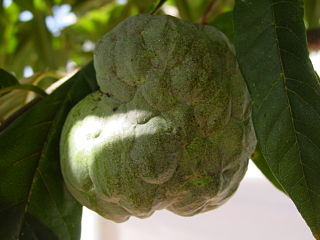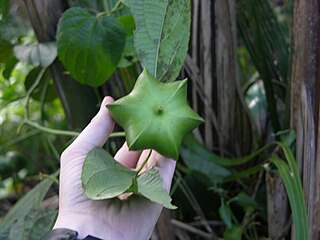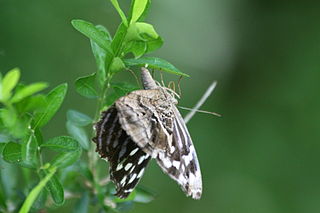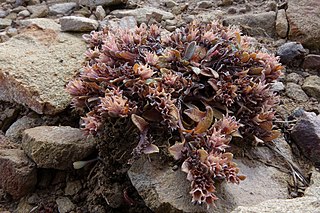
Euphorbia is a very large and diverse genus of flowering plants, commonly called spurge, in the family Euphorbiaceae.

Iridaceae is a family of plants in order Asparagales, taking its name from the irises. It has a nearly global distribution, with 69 accepted genera with a total of c. 2500 species. It includes a number of economically important cultivated plants, such as species of Freesia, Gladiolus, and Crocus, as well as the crop saffron.

The Annonaceae are a family of flowering plants consisting of trees, shrubs, or rarely lianas commonly known as the custard apple family or soursop family. With 108 accepted genera and about 2400 known species, it is the largest family in the Magnoliales. Several genera produce edible fruit, most notably Annona, Anonidium, Asimina, Rollinia, and Uvaria. Its type genus is Annona. The family is concentrated in the tropics, with few species found in temperate regions. About 900 species are Neotropical, 450 are Afrotropical, and the remaining are Indomalayan.

Hamamelidaceae, commonly referred to as the witch-hazel family, is a family of flowering plants in the order Saxifragales. The clade consists of shrubs and small trees positioned within the woody clade of the core Saxifragales. An earlier system, the Cronquist system, recognized Hamamelidaceae in the Hamamelidales order.

Paulowniaceae are a family of flowering plants within the Lamiales. They are a monophyletic and monogeneric family of trees with currently 7 confirmed species. They were formerly placed within Scrophulariaceae sensu lato, or as a segregate of the Bignoniaceae.

Physalis is a genus of approximately 75 to 90 flowering plants in the nightshade family (Solanaceae), which are native to the Americas and Australasia. At least 46 species are endemic to Mexico. Cultivated and weedy species have been introduced worldwide. A defining feature of Physalis is a large, papery husk derived from the calyx, which partly or fully encloses the fruit. Many species bear edible fruit, and some species are cultivated.
Dioecy is a characteristic of certain species that have distinct unisexual individuals, each producing either male or female gametes, either directly or indirectly. Dioecious reproduction is biparental reproduction. Dioecy has costs, since only the female part of the population directly produces offspring. It is one method for excluding self-fertilization and promoting allogamy (outcrossing), and thus tends to reduce the expression of recessive deleterious mutations present in a population. Plants have several other methods of preventing self-fertilization including, for example, dichogamy, herkogamy, and self-incompatibility.

Plukenetieae is a tribe of plant of the family Euphorbiaceae. It comprises 3 subtribes and 14 genera. Tribe Plukenetieae (Benth.) Hutch. is a diverse pantropical lineage of ca. 17 genera and 350 species of twining vines and lianas, scandent to erect perennial herbs and subshrubs, and rarely shrubs and small trees.

Adelia is a genus of flowering plants in the spurge family, Euphorbiaceae, subfamily Acalyphoideae. It is native to Latin America and the Caribbean, with one species extending northward into the southernmost part of Texas.

Dalechampia is a genus of plant of the family Euphorbiaceae and of the monogeneric subtribe Dalechampiinae. It is widespread across lowland tropical areas primarily in the Americas with smaller numbers of species in Africa, Madagascar, and southern Asia. Additional new species are still being described and several are very rare and at risk of extinction.
Amanoeae is a tribe of the family Phyllanthaceae. It comprises 2 genera.

Rhipsalis is a genus of epiphytic flowering plants in the cactus family, typically known as mistletoe cacti. They are found in parts of Central America, the Caribbean and northern regions of South America. They also inhabit isolated locations in Africa and Asia, and are the only cactus group naturally occurring in the Old World. This is the largest and most widely distributed genus of epiphytic cacti.

Dichorisandra is a genus of perennial monocotyledonous flowering plants in the dayflower family (Commelinaceae). It is found in the Neotropics. The genus is characterised by its slightly zygomorphic flowers with large anthers usually releasing pollen by means of pores at the apex, as well as by its seeds that are embedded in a red or sometimes white aril, and tubers that often form at the tips of the roots. Both morphology and an analysis of DNA sequences indicate it is very closely related to the genus Siderasis.

Toxomerus is a very large genus of hoverflies. They are found in many parts of North and South America. Most larvae are predators on soft bodied insects, though a few species have been shown to feed on pollen. Adults feed on the pollen of a wide range of flowers.
Alan W. Meerow is an American botanist, born in New York City in 1952. He specializes in the taxonomy of the family Amaryllidaceae and the horticulture of palms and tropical ornamental plants. He also works on the population genetics and molecular systematics of cycads and palms.

Peraceae Klotzsch is a family of flowering plants in the eudicot order Malpighiales. The family was segregated from the Euphorbiaceae by Johann Friedrich Klotzsch in 1859, and its uniqueness was affirmed by the Royal Botanic Gardens, Kew's Euphorbiaceae expert, Airy Shaw.

The Solanaceae, or the nightshades, are a family of flowering plants that ranges from annual and perennial herbs to vines, lianas, epiphytes, shrubs, and trees, and includes a number of agricultural crops, medicinal plants, spices, weeds, and ornamentals. Many members of the family contain potent alkaloids, and some are highly toxic, but many—including tomatoes, potatoes, eggplant, bell, and chili peppers—are used as food. The family belongs to the order Solanales, in the asterid group and class Magnoliopsida (dicotyledons). The Solanaceae consists of about 98 genera and some 2,700 species, with a great diversity of habitats, morphology and ecology.
Paul Irwin Forster is an Australian botanist. He obtained his doctorate from the University of Queensland in 2004 with his thesis The pursuit of plants : studies on the systematics, ecology and chemistry of the vascular flora of Australia and related regions.
Paul Edward Berry is an American botanist and curator. He is Director of the Wisconsin State Herbarium.

Myosotis glauca is a species of flowering plant in the family Boraginaceae, endemic to the South Island of New Zealand. George Simpson and J.S. Thomson described M. pygmaea var. glauca in 1942, and Peter de Lange and John Barkla recognized it at species rank in 2010. Plants of this species of forget-me-not are perennial with a prostrate habit, bracteate inflorescences, white corollas, and often glaucous grey leaves.














